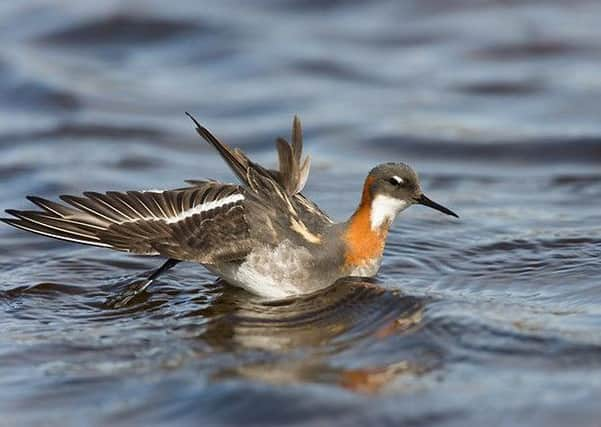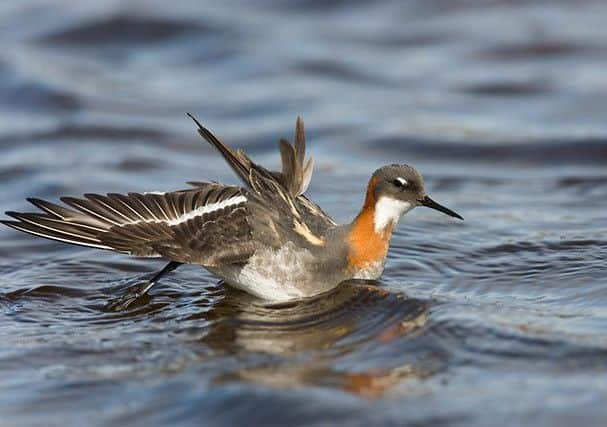From Shetland to Peru: epic bird migration tracked


The epic migration of the small and delicate red-necked phalarope - a first for any European bird - was uncovered after data from the device was recovered when the bird was caught following its return to the Northern Isles.
Experts at RSPB Scotland were left astounded after the data showed that the wader, one of the rarest birds in the UK, had flown from Shetland across the Atlantic via Iceland and Greenland, then south down the Eastern seaboard of America, across the Caribbean and Mexico, before ending up off the coast of Ecuador and Peru.
Advertisement
Hide AdAdvertisement
Hide AdAfter spending the wintering the Pacific, it then returned to Fetlar, following a similar route.


Malcie Smith of the RSPB on Shetland said: “To think this bird, which is smaller than a starling, can undertake such an arduous journey and return safely to Shetland is truly extraordinary. This tiny tracker has provided a valuable piece of the puzzle when building a picture of where phalaropes go when they leave our shores.”
He admitted: “We hadn’t realised that some Scottish birds were travelling thousands of miles to join other wintering populations in the Pacific Ocean. Intriguingly, if the usual wintering area of Scottish red-necked phalaropes is indeed in the eastern Pacific, then this Scottish breeding bird may be directly affected by periodic ‘El Nino’ events when these Pacific waters become warmer and the supply of plankton is greatly reduced. With that in mind, the project, which we will continue, will be vital when considering any future conservation of this rare and special bird.”
Experts has previously assumed that the small Scottish breeding population of phalaropes joined the Scandinavian population at their wintering grounds in the Arabian Sea.
Mr Smith said: “We are freezing up here in Shetland and it’s quite nice to think of our red necked phalaropes bobbing about in the warm tropical waters of the Pacific. What it tells us is that this bird isn’t part of an offshoot population from Scandinavia. Our Shetland population is actually an offshoot of a North American population.
“It means that what we thought was a kind of medium-distance migrant is actually a long-distance migrant. It is one of the world’s great migrations.”
The red-necked phalarope is on the RSPB’s “Red List” of species at risk in the UK. There are estimated to be only 15 to 50 breeding males which are only found in the Northern and Western Isles.
The waders are adapted well to spending a lot of time on water. Unlike other waders, phalaropes have lobed toes which enable them to swim strongly when on pools or out at sea. They spend most of their time in the water but can equally run about on land. The duller coloured male looks after the eggs and young after laying.
Advertisement
Hide AdAdvertisement
Hide AdAn RSPB spokeswoman explained: “The RSPB, working in collaboration with the Swiss Ornithological Institute and Dave Okill of the Shetland Ringing Group, fitted individual geolocators to ten red-necked phalaropes nesting on Fetlar in summer 2012 in the hope of learning where they spend the winter
“Ten geolocators were fitted to six male and four female birds. Each geolocator weighs 0.6g and is fitted to the bird with harnesses made from silastic tubing. Both the fitting and recapturing was conducted by experienced bird ringers under licence from the British Trust for Ornithology.
“Whilst one fell off before the bird migrated, of the remaining nine birds that left with tags intact, four returned to the reserve in Summer 2013, two still wearing their tracking devices. Researchers successfully managed to recapture the tagged male as it returned to its nest. However, despite much effort they were unable to catch the other tagged female.”
She continued: “After successfully recapturing one of the tagged birds when it returned to Fetlar last spring, experts discovered it had made an epic 16,000 mile round trip during its annual migration - flying from Shetland across the Atlantic, south down the eastern seaboard of the US, across the Caribbean, and Mexico, ending up off the coast of Peru.
“After wintering in the Pacific, it returned to Fetlar, following a similar route. Prior to this, many experts had assumed that Scottish breeding phalaropes joined the Scandinavian population at their wintering grounds, thought to be in the Arabian Sea. Yet the destination of this Scottish red-necked phalarope was the Pacific Ocean.”
She continued: “The red-necked phalarope is one of the UK’s rarest breeding birds. It is now only found in Shetland and the Western Isles, and numbers fluctuate between just 15 and 50 nesting males. Scotland marks the southern limit of its breeding range, with the species far more abundant further north where it occupies wetlands around the northern hemisphere. Famed for turning the tables on traditional gender roles, in summer, male birds can be found incubating eggs and raising young, whilst the female uses her brightly coloured plumage to attract new partners.
“In winter, phalaropes congregate in large flocks at sea in regions where currents create upwellings of cold, nutrient-rich water and support blooms of plankton on which the birds feed. By continuing the project and retrieving more tags from phalaropes after the next winter migration, experts hope to learn the extent to which the Scottish population may be impacted by future changes at sea, how the species might respond to any change and whether any negative impacts in these wintering areas can be mitigated by conservation management here in Scotland.”